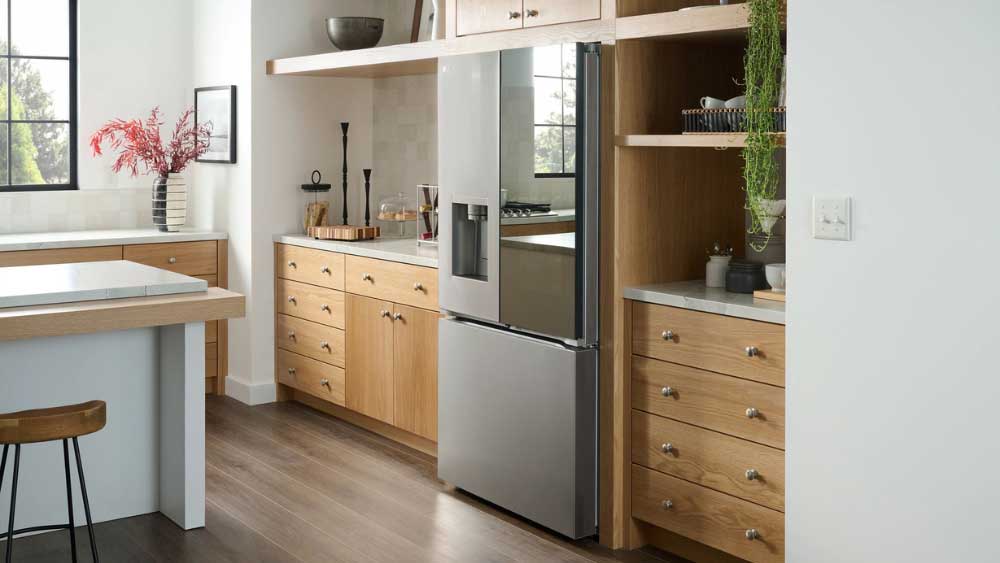TL;DR: Counter-Depth vs. Standard-Depth Refrigerators
- Counter-depth now reaches 26.5 cu ft (LG and Samsung).
- Choose counter-depth for a near-flush look and easier aisles; confirm wall and hinge clearance.
- Choose standard depth for maximum space (27 to 30 cu ft) and lower cost per cubic foot.
- Bottom line: You can get design and space with 26.5 cu ft counter-depth; standard depth still wins on pure capacity.
For decades, refrigerator shopping meant a trade-off.
Standard-depth models offered up to 30 cubic feet but stuck out past your cabinets and often showed black side panels.
Counter-depth models delivered a smooth, built-in look (flush doors, clean lines, no visible sides) but sacrificed capacity, typically topping out at 20–23 cubic feet.
That was the deal: more space or a cleaner look.
By late 2024, LG and Samsung upended the trade-off with counter-depth refrigerators offering up to 26.5 cubic feet, nearly matching standard-depth capacity without jutting into your kitchen.
For the first time, you don’t have to choose.
What You'll Learn
- Compare counter-depth vs. standard-depth on capacity, fit, and appearance
- Estimate how much storage you actually need for your household
- See what changed in 2024/2025 to make 26.5 cu. ft. counter-depth possible
- Understand the key trade-offs: wall clearance, brand availability, and service
- Decide when to choose counter-depth, standard-depth, or integrated, and why
- Explore popular LG and Samsung models to start your research
Looking for answers about Counter-Depth Refrigerators?
Short on time? Download our free Counter-Depth Refrigerator Buying Guide.
A Quick Note on Terminology
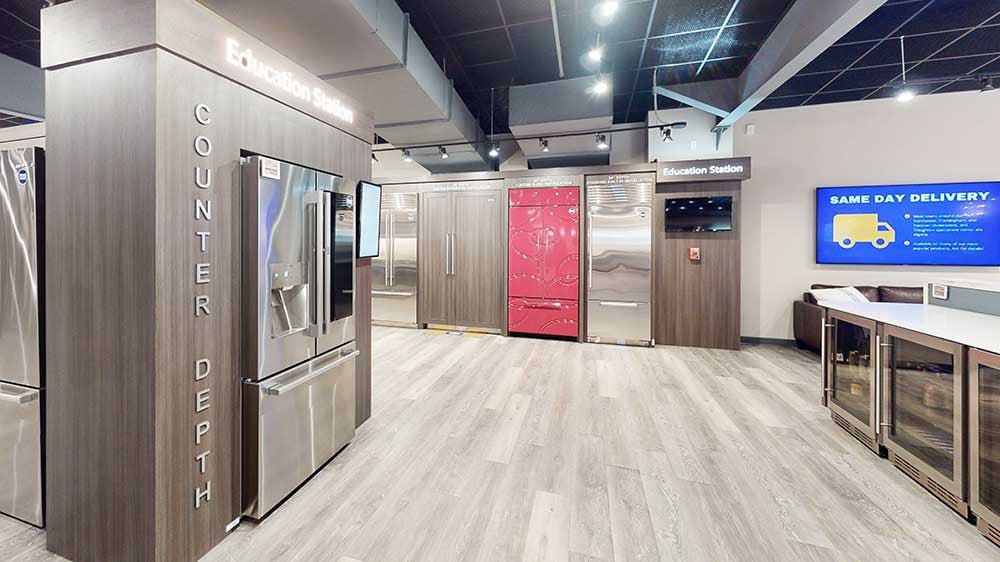
This article focuses on freestanding counter-depth refrigerators, where the doors sit nearly flush but the case extends a few inches.
Integrated refrigerators (e.g., Sub-Zero, Thermador) are fully flush and designed to disappear into cabinetry; we cover those in separate articles.
Counter-Depth vs. Standard Refrigerators
Quick Comparison: Capacity at a Glance
| |
Brand/Model |
Capacity (cu. ft.) |
Dimensions (hxwxd) |
Notes |
| Counter-Depth (traditional) |
Bosch B36CL80SNS |
20.5 |
~70" x 36" x 24" |
Sleek look, but smaller storage |
| Mid-Range Counter-Depth |
GE Profile PYE22KYNFS |
22.1 |
~70" x 36" x 29" |
Solid middle ground |
| Counter-Depth MAX |
LG & Samsung (2024/25) |
26.5 |
~70" x 36" x 28" |
Near-standard capacity |
| Standard-Depth (Typical) |
GE/Whirlpool/KitchenAid |
27–28 |
~70" x 36" x 33" |
More space, bulkier design |
| Standard-Depth MAX |
LG & Samsung |
30 |
~70" x 36" x 33" |
Largest models available |
What Is a Standard-Depth Refrigerator?
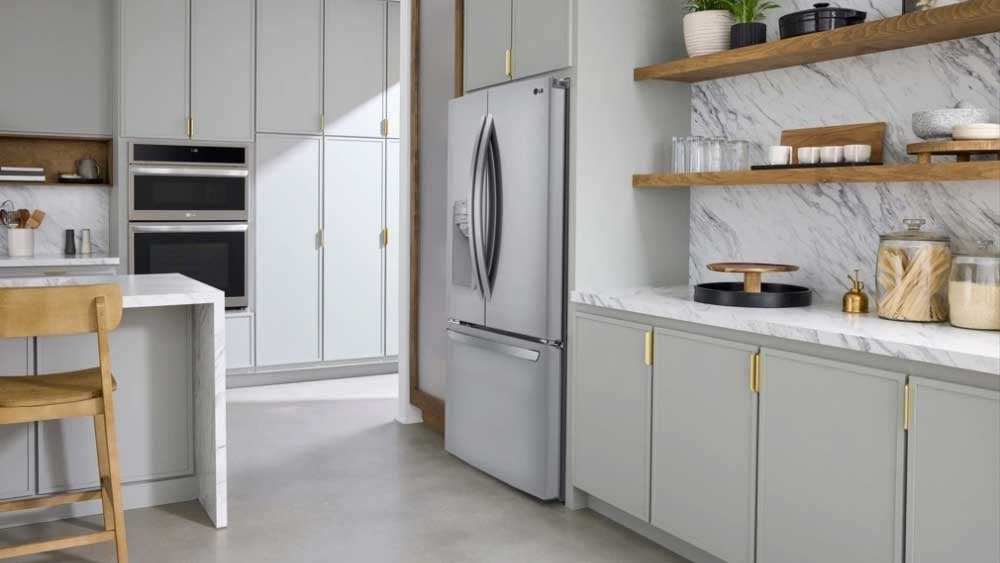
A full-depth freestanding refrigerator built to maximize interior space. If you need the most storage, standard depth is the easiest way to get it.
- Depth: 30–36 inches; expect the case to project about 5–8 inches past standard countertops.
- Capacity: Up to 30 cu. Ft.
- Look: Sticks out past your cabinets; side panels may be visible.
- Fit and clearance: Requires more aisle space and full door swing. Confirm clearance for islands, adjacent walls, plug, water line, and ventilation.
- Cost: Usually a lower price per cubic foot than counter depth.
- Why buy: Maximum storage for big families or bulk shoppers.
What Is a Counter-Depth Refrigerator?
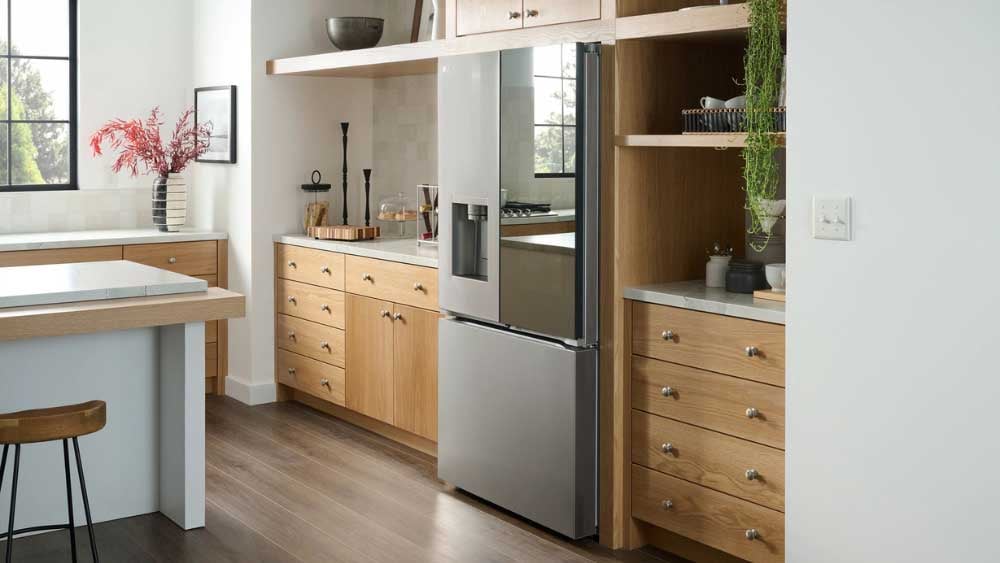
A shallower freestanding refrigerator designed to line up better with cabinetry for a cleaner look.
Choose counter depth to keep traffic flowing and get a built-in aesthetic without going fully integrated.
- Depth: 24–30 inches; doors sit nearly flush, but the case typically extends a few inches beyond cabinets.
- Capacity: Traditionally 20–23 cu. ft. (newer options reach higher, covered below).
- Look: Flush-looking doors, cleaner lines, minimal side visibility when recessed in a niche.
- Fit and clearance: Easier walkway clearance around islands. Still verify hinge and wall clearance and measure carefully for tight installs.
- Cost: Typically a higher price per cubic foot than standard depth.
- Why buy: Better design and kitchen flow, especially in open plans or tight aisles.
Now that you know how standard and counter depth differ on fit and appearance, start by sizing your storage needs.
How Much Refrigerator Space Do You Really Need?
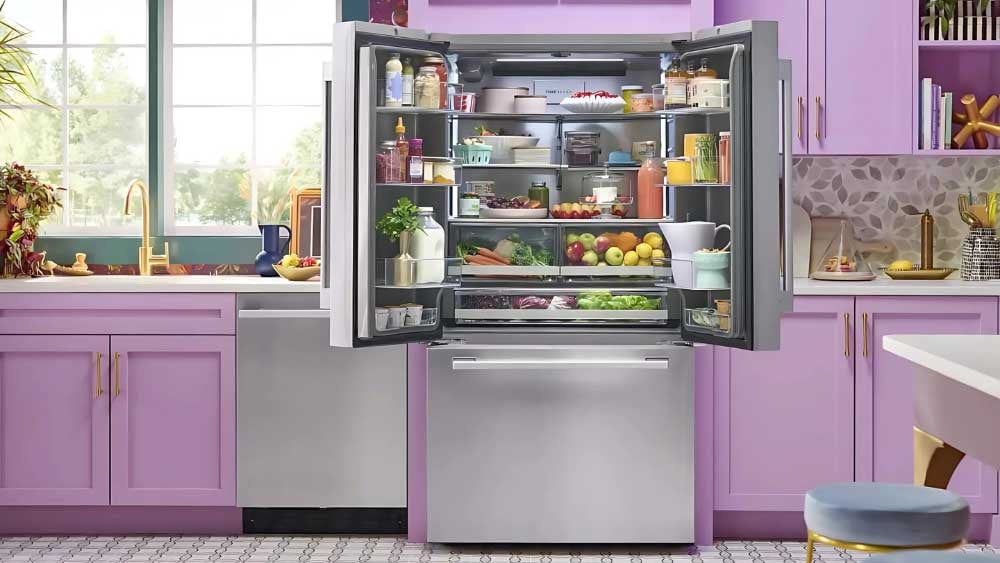
There’s no one-size-fits-all answer; here’s how to think about it.
- 1–2 people: 20–22 cu. ft. usually works
- 3–5 people: 23–26 cu. ft. is enough for weekly shopping
- Large households or entertainers: 28–30 cu. ft. (or a second fridge)
📝 Editor’s Note: I grew up in a family of five. We had an old 23-cubic-foot Amana that handled pretty much everything.
My parents kept meat, for some reason, in a separate freezer in the basement.
It depends on how many people are in your household and how you shop. I have a 20-cubic-foot fridge for my daughter and me.
I added a set of refrigerator drawers for drinks, but those could easily fit in the refrigerator.
A Short History of Counter-Depth Refrigerators

Sub-Zero invented the built-in look in the 1960s, introducing the first panel-ready refrigerators that blended seamlessly into kitchens.
Then, in the 1990s, Amana launched the first freestanding counter-depth fridge. It cost far less than a Sub-Zero and gave homeowners that sleek look without the premium price tag.
Models from GE, KitchenAid, and Maytag followed. But for decades, capacity topped out around 20–23 cubic feet.
If you wanted more storage, you had to live with a standard-depth fridge that stuck out.
That’s how things stayed until 2024.
The LG and Samsung Disruption
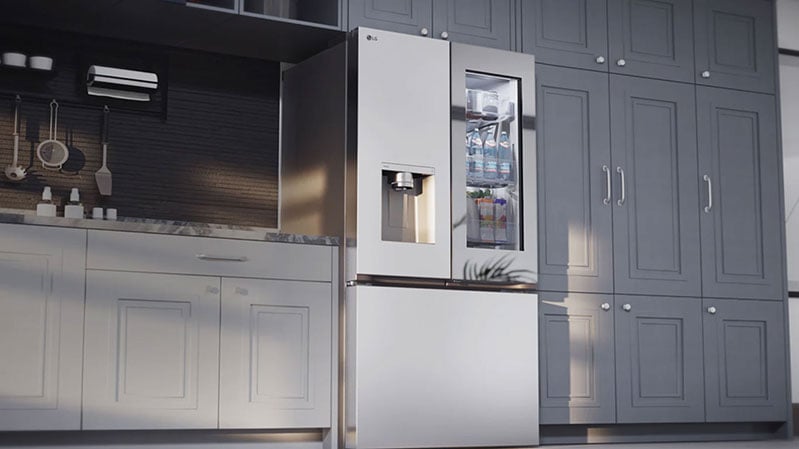
LG and Samsung introduced 26.5 cu. ft. counter-depth models, the largest we have seen in this category. You get near standard-depth storage in a counter-depth footprint.
- Storage: On par with many standard-depth refrigerators
- Design: Doors stay nearly flush for a built-in look
- Fit: Works for most households
How They Did It:
- Thinner walls and better insulation for more interior space
- Simplified cooling systems to free up room
- Larger doors with deeper bins for extra storage
Popular LG & Samsung Models
LG
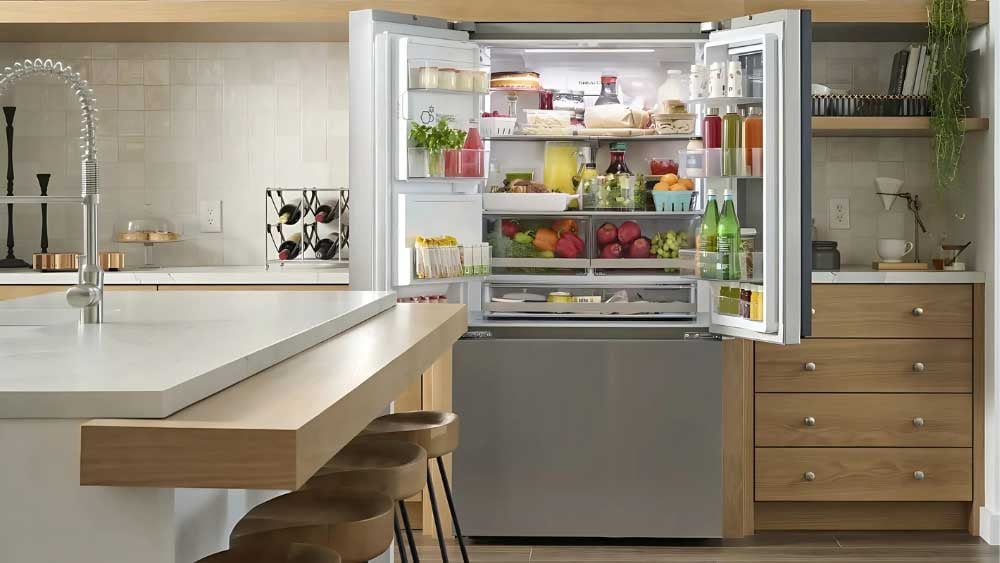
Samsung
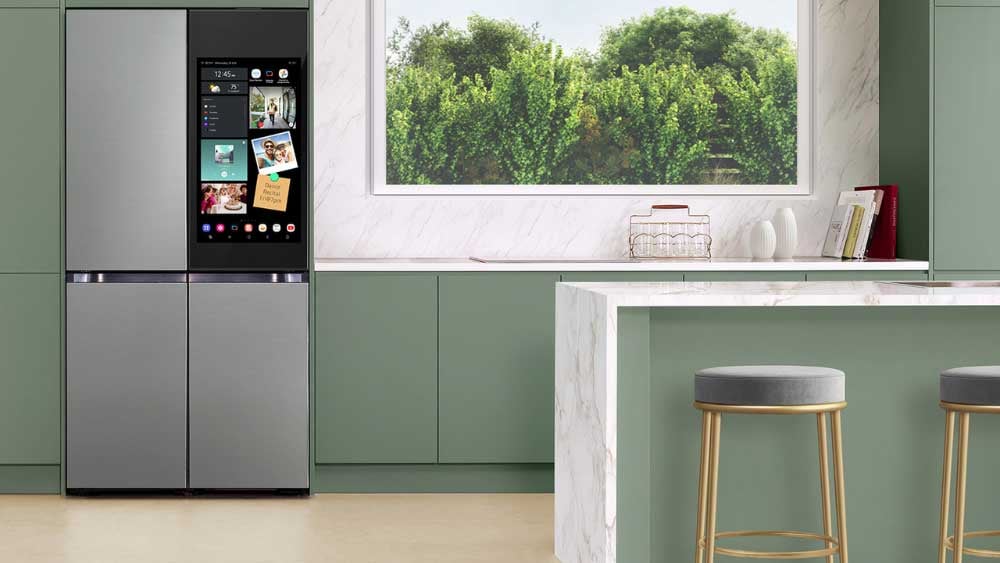
- Entry-Level: RF24BB6600 ($2,000)
- Family Hub: RF23DB9900QDAA with touchscreens and apps ($3,399)
The Trade-Offs
There are still limits, so confirm your space and service before you buy.
- Limited Brands: Only LG and Samsung currently offer this size
- Wall Clearance: Doors need several inches of space to open fully
- Service: Support may vary by location
The Zero Clearance Solution
Premium brands like Sub-Zero and Thermador offer zero-clearance doors that open fully even when installed against a wall.
Now LG has a more affordable option:
LG Counter Depth MAX with Zero Clearance French Door Refrigerator
- Model: LG LF24Z6530S
- Capacity: 23.7 cu. ft.
- Benefit: Fits tight spaces without losing accessibility
Unless you’re buying premium, this is the only freestanding counter-depth fridge designed for wall installations.
Verdict: Now You Have Choices
You can still buy:
- A 30 cu. ft. standard-depth for maximum space, or
- 20–23 cu. ft. counter-depth for a sleeker look.
But now, you also have a third option:
- A 26.5 cu. ft. counter-depth that delivers both design and storage.
Just remember the trade-offs: limited brands and not ideal for wall installs.
Bottom line: For the first time, you don’t have to settle.
Additional Resources
Download the Yale Counter Depth Refrigerator Buying Guide with features, specs, and inside buying tips for regular, pro, and integrated counter-depth refrigerators.
Well over 1 million people have read a Yale Guide.
Related Articles:
Why Should You Trust Us?
It seems that every appliance review has nothing but glowing comments about almost every product, yet you read customer reviews and they are almost universally bad.
We are here to fill in the disconnect. We'll give you the best features, and the drawbacks as well, including reliability based on over 37,000 calls performed by our service team just last year. Our goal is to give you ALL the information so you know what's right for you.
Please consider subscribing or adding to the conversation in the comments below. We appreciate you stopping by.
Steve Sheinkopf
Steve Sheinkopf is the third-generation CEO of Yale Appliance and a lifelong Bostonian. He has over 38 years of experience in the appliance industry, and he is a trusted source of information for consumers on how to buy and repair appliances.
Steve has also been featured in numerous publications, including the
New York Times,
Consumer Reports,
The Boston Globe,
Bloomberg Radio, the
New York Post,
The Wall Street Journal, and
Entrepreneur, for his knowledge of how to buy appliances and appliance repair.
Steve is passionate about helping consumers find the best appliances for their needs, and he is always happy to answer questions and provide advice. He is a valuable resource for consumers who are looking for information on appliance buying, repair, and maintenance.
Despite being the worst goalie in history, Steve is a fan of the Bruins and college hockey, loves to read, and is a Peloton biker. The love of his life is his daughter, Sophie.


